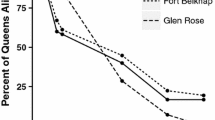Abstract
In ants, nest relocations are frequent but nevertheless perilous, especially for the reproductive caste. During emigrations, queens are exposed to predation and face the risk of becoming lost. Therefore the optimal strategy should be to move the queen(s) swiftly to a better location, while maintaining maximum worker protection at all times in the new and old nests. The timing of that event is a crucial strategic issue for the colony and may depend on queen number. In monogynous colonies, the queen is vital for colony survival, whereas in polygynous colonies a queen is less essential, if not dispensable. We tested the null hypothesis that queen movement occurs at random within the sequence of emigration events in both monogynous and polygynous colonies of the ponerine ant Pachycondyla obscuricornis. Our study, based on 16 monogynous and 16 polygynous colony emigrations, demonstrates for the first time that regardless of the number of queens per colony, the emigration serial number of a queen occurs in the middle of all emigration events and adult ant emigration events, but not during brood transport events. It therefore appears that the number of workers in both nests plays an essential role in the timing of queen movement. Our results correspond to a robust colony-level strategy since queen emigration is related neither to colony size nor to queen number. Such an optimal strategy is characteristic of ant societies working as highly integrated units and represents a new instance of group-level adaptive behaviors in social insect colonies.

Similar content being viewed by others
References
Bourke AGF, Franks NR (1995) Social evolution in ants. Princeton University Press, Princeton, N.J.
Byrne MM (1994) Ecology of twig-dwelling ants in a wet lowland tropical forest. Biotropica 26:61–72
Cox DR, Lewis PAW (1968) The statistical analysis of series of events. Methuen, London
Franks NR, Dornhaus A (2003) How might individual honeybees measure massive volumes? Proc R Soc Lond B 270:181–182
Franks NR, Partridge LW (1993) Lanchester battles and the evolution of combat in ants. Anim Behav 45:197–199
Franks NR, Sendova-Franks AB (2000) Queen transport during ant colony emigration: a group-level adaptive behavior. Behav Ecol 11:315–318
Franks, NR, Pratt SC, Mallon EB, Britton NF, Sumpter DJT (2002) Information flow, opinion-polling and collective intelligence in house-hunting social insects. Philos Trans R Soc Lond B 357:1567–1583
Fresneau D (1984) Développement ovarien et statut social chez une fourmi primitive Neoponera obscuricornis Emery (Hym. Formicidae, Ponerinae). Insect Soc 31:387–402
Gordon DM, Paul REH, Thorpe K (1993) What is the function of encounter patterns in ant colonies? Anim Behav 45:1083–1100
Hölldobler B, Hengel H (1978) Tergal and sternal glands in ants. Psyche 85:285–330
Hölldobler B, Wilson EO (1990) The ants. Harvard University Press, Cambridge, Mass.
Keller L (1993) Queen number and sociality in insects. Oxford University Press, Oxford
Kuriachan I, Vinson SB (2000) A queen’s worker attractiveness influences her movement in polygynous colonies of the red imported fire ant (Hymenoptera: Formicidae) in response to adverse temperatures. Environ Entomol 29:943–949
Mugford ST, Mallon EB, Franks NR (2001) The accuracy of Buffon’s needle: a rule of thumb used by ants to estimate area. Behav Ecol 12:655–658
Pratt SC, Mallon EB, Sumpter DJT, Franks NR (2002) Quorum sensing, recruitment, and collective decision-making during colony emigration by the ant Leptothorax albipennis. Behav Ecol Sociobiol 52:117–127
Seeley TD (1997) Honey bee colonies are group-level adaptive units. Am Nat 150:S22–S41
Traniello JFA, Hölldobler B (1984) Chemical communication during tandem running in Pachycondyla obscuricornis (Hymenoptera: Formicidae). J Chem Ecol 10:783–794
Acknowledgements
We thank R. Fénéron, R. Blatrix, and two anonymous referees for their helpful comments on an earlier version of this article. This work was partially supported by the French Department of Education and Research. The authors are grateful to the LEEC for funding of the 2002 field study in French Guiana.
Author information
Authors and Affiliations
Corresponding author
Rights and permissions
About this article
Cite this article
Pezon, A., Denis, D., Cerdan, P. et al. Queen movement during colony emigration in the facultatively polygynous ant Pachycondyla obscuricornis. Naturwissenschaften 92, 35–39 (2005). https://doi.org/10.1007/s00114-004-0583-z
Received:
Accepted:
Published:
Issue Date:
DOI: https://doi.org/10.1007/s00114-004-0583-z




